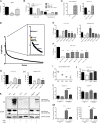Complement pathway amplifies caspase-11-dependent cell death and endotoxin-induced sepsis severity
- PMID: 27697835
- PMCID: PMC5068231
- DOI: 10.1084/jem.20160027
Complement pathway amplifies caspase-11-dependent cell death and endotoxin-induced sepsis severity
Abstract
Cell death and release of proinflammatory mediators contribute to mortality during sepsis. Specifically, caspase-11-dependent cell death contributes to pathology and decreases in survival time in sepsis models. Priming of the host cell, through TLR4 and interferon receptors, induces caspase-11 expression, and cytosolic LPS directly stimulates caspase-11 activation, promoting the release of proinflammatory cytokines through pyroptosis and caspase-1 activation. Using a CRISPR-Cas9-mediated genome-wide screen, we identified novel mediators of caspase-11-dependent cell death. We found a complement-related peptidase, carboxypeptidase B1 (Cpb1), to be required for caspase-11 gene expression and subsequent caspase-11-dependent cell death. Cpb1 modifies a cleavage product of C3, which binds to and activates C3aR, and then modulates innate immune signaling. We find the Cpb1-C3-C3aR pathway induces caspase-11 expression through amplification of MAPK activity downstream of TLR4 and Ifnar activation, and mediates severity of LPS-induced sepsis (endotoxemia) and disease outcome in mice. We show C3aR is required for up-regulation of caspase-11 orthologues, caspase-4 and -5, in primary human macrophages during inflammation and that c3aR1 and caspase-5 transcripts are highly expressed in patients with severe sepsis; thus, suggesting that these pathways are important in human sepsis. Our results highlight a novel role for complement and the Cpb1-C3-C3aR pathway in proinflammatory signaling, caspase-11 cell death, and sepsis severity.
© 2016 Napier et al.
Figures







References
-
- Ames R.S., Lee D., Foley J.J., Jurewicz A.J., Tornetta M.A., Bautsch W., Settmacher B., Klos A., Erhard K.F., Cousins R.D., et al. . 2001. Identification of a selective nonpeptide antagonist of the anaphylatoxin C3a receptor that demonstrates antiinflammatory activity in animal models. J. Immunol. 166:6341–6348. 10.4049/jimmunol.166.10.6341 - DOI - PubMed
-
- Ardura M.I., Banchereau R., Mejias A., Di Pucchio T., Glaser C., Allantaz F., Pascual V., Banchereau J., Chaussabel D., and Ramilo O.. 2009. Enhanced monocyte response and decreased central memory T cells in children with invasive Staphylococcus aureus infections. PLoS One. 4:e5446 10.1371/journal.pone.0005446 - DOI - PMC - PubMed
MeSH terms
Substances
Grants and funding
LinkOut - more resources
Full Text Sources
Other Literature Sources
Medical
Molecular Biology Databases
Miscellaneous

